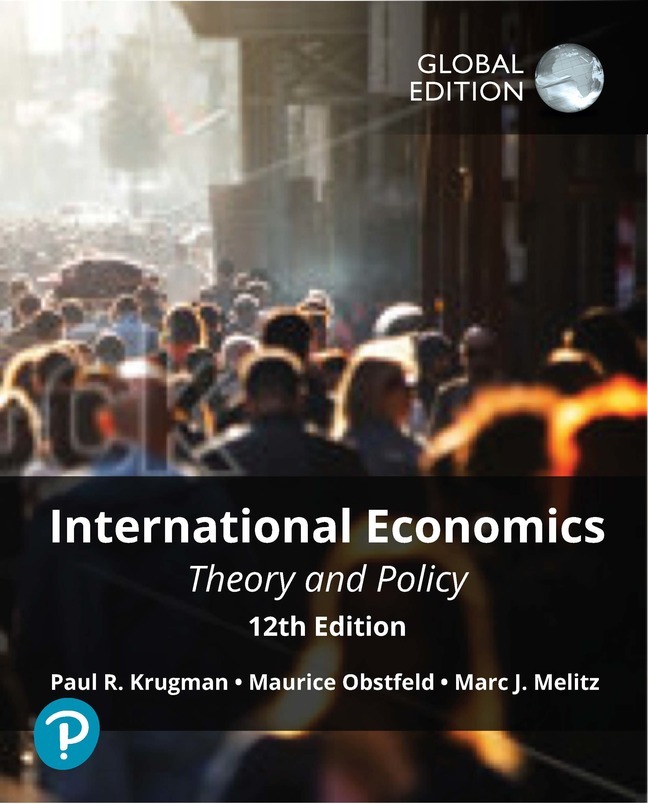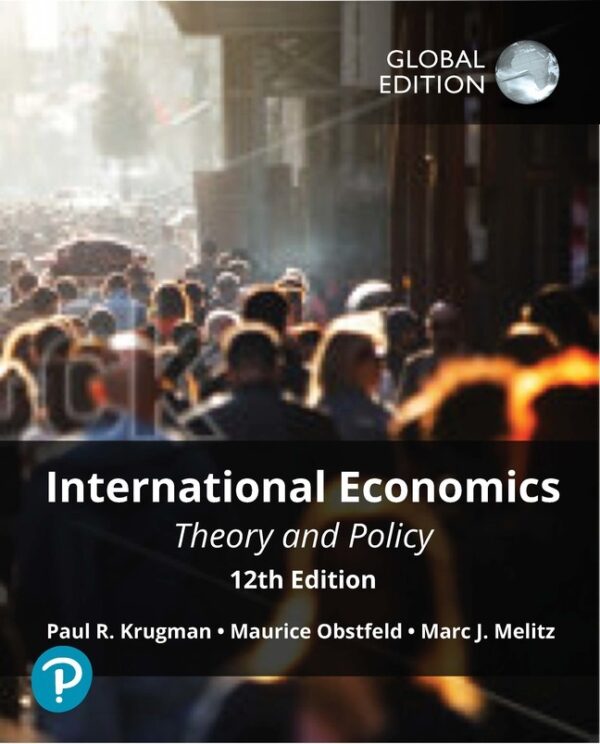Description
For courses in International Economics, International Finance, and International Trade.
A balanced approach to theory and policy applications
International Economics: Theory and Policy provides engaging, balanced coverage of the key concepts and practical applications of the two main topic areas of the discipline. For both international trade and international finance, an intuitive introduction to theory is followed by detailed coverage of policy applications. With this new Eleventh Edition, Global Edition, the author team of Nobel Prize-winning economist Paul Krugman, renowned researcher Maurice Obstfeld, and Marc Melitz of Harvard University, continues to set the standard for International Economics courses.
Pearson MyLabTM Economics not included. Students, if Pearson MyLab Economics is a recommended/mandatory component of the course, please ask your instructor for the correct ISBN and course ID. MyLab Economics should only be purchased when required by an instructor. Instructors, contact your Pearson rep for more information.
Pearson MyLab Economics is an online homework, tutorial, and assessment product designed to personalize learning and improve results. With a wide range of interactive, engaging, and assignable activities, students are encouraged to actively learn and retain tough course concepts.
Features
This title is a Pearson Global Edition. The Editorial team at Pearson has worked closely with educators around the world to include content, which is especially relevant to students outside the United States.
About the book
Reveal theory and applications of trade and finance via a unified structure
The text’s unified structure presents a balance of theoretical and practical coverage of international finance. Chapters on core theory are followed by a series of application chapters that confront policy questions using the newest empirical work, data, and policy debates. This structure enables students to grasp theoretical concepts and then see those same concepts in action, aiding retention and highlighting the relevance of course material. Highlights include:
A unified model of open-economy macroeconomics that provides students with a cohesive approach to the theory, based on an asset-market approach to exchange rate determination with expectations in a central role.
A discussion of the international monetary experience that stresses the idea that different exchange rate systems lead to different policy coordination problems.
An emphasis on the potential substitutability of international trade and international movements of factors of production, featuring an analysis of international borrowing and lending as intertemporal trade–the exchange of present consumption for future consumption.
Give students learning tools to master course material
Learning Goals list essential concepts so students understand what they need to take away from each chapter.
Case Studies illustrate theory using real-world applications and provide important historical context.
Special Boxes offer vivid illustrations of points made in the text, including the role of currency swap lines among central banks, and the rapid accumulation of foreign exchange reserves by developing countries.
200+ Captioned diagrams reinforce discussions in the text and help students in reviewing the material.
Summary and Key Terms. Each chapter closes with a summary recapping the major points to aid student review of the material.
· Problems, many of which cite real data or policies, allow students to practice what they’re learning. They range from routine computational drills to more analytical questions and problems. All end-of-chapter problems are included in MyLab™ Economics so that instructors can assign homework without needing to grade students’ work by hand.
· Further Reading sections at the end of each chapter provide annotated bibliographies of both seminal works and recent articles, encouraging students to explore the material further.
Relay recent developments in the theoretical and practical sides of international finance
UPDATED! Additional coverage of relevant topics and events including the impact of the Automobile Intra-Industry Trade within the Association of Southeast Asian Nations-4 (ASEAN-4), namely Indonesia, Malaysia, the Philippines, and Thailand between 1998–2002; the origin of tariff-rate quotas and its practical application with oilseeds, noting that tariff quotas for these goods are more often applied than those for the traditionally protected products, like dairy or sugar; the role of negative interest rates in unconventional monetary policy; and the increasingly important role of emerging market economies in driving global growth.
NEW! Box describes China’s offshore market and the relationship between its onshore and offshore exchange rates (Chapter 3).
NEW! Box on the role of invoice currencies in exchange-rate pass-through and discussion of the role of negative interest rates in unconventional monetary policy (Chapter 6).
NEW! Box describes the dangers of deflation (Chapter 8).
NEW! Box on Brexit, specifically the process through which Britain is likely to leave the EU (Chapter 10).
NEW! Coverage of the key role of commodities in developing-country growth, and the commodity “super cycle” (Chapter 11).
Pearson MyLabTM Economics not included. Students, if MyLab is a recommended/mandatory component of the course, please ask your instructor for the correct ISBN and course ID. MyLab should only be purchased when required by an instructor. Instructors, contact your Pearson representative for more information.
- An online homework and tutorial system puts students in control of their own learning. Within the Pearson Pearson MyLab Economics structured environment, students practice what they learn, test their understanding, and then pursue a study plan that the Pearson MyLab Economics generates for them based on their performance on practice tests.
- Question Help. Homework and practice questions in Pearson MyLab Economics are correlated to the textbook, generate algorithmically to give students unlimited opportunity for practice and mastery, and offer helpful feedback when students enter incorrect answers. Questions include guided solutions and other multimedia assets for extra help at point-of-use.
- Animated Graphs in Pearson MyLab Economics accompany many of the key graphs and figures in the text, and have been updated with real-time data from FRED™ (Federal Reserve Economic Data)–a comprehensive, up-to-date data set maintained by the Federal Reserve Bank of St. Louis. Students can display a pop-up graph that shows new data plotted in the graph, to better understand how to work with data and understand how including new data affects graphs. More dynamic than graphs on a printed page, these animated ones help students understand shifts in curves, movements along curves, and changes in equilibrium values.
- Real-Time Data Analysis. These exercises allow instructors to assign problems that use up-to-the-minute data. Each RTDA exercise loads the appropriate and most currently available data from FRED. Exercises are graded based on that instance of data, and feedback is provided.
- Interactive Homework Exercises. Participate in a fun, engaging, and easy-to-use activity that helps promote active learning and mastery of important economic concepts.
- Flexible tools allow instructors to easily and effectively customize online course materials to suit their needs. Instructors can create and assign tests, quizzes, or homework assignments. Pearson MyLab Economics saves time by tracking results in an online gradebook. After registering for Pearson MyLab Economics, instructors can also access downloadable supplements.
- Interactive Solved Problems. Each of the Solved Problems in the text is accompanied by a similar problem in Pearson MyLab Economics, so students can practice and build their problem-solving skills. These interactive tutorials help students learn to think like economists and apply basic problem-solving skills to homework, quizzes, and exams. The goal is for students to build skills they can use to analyze real-world economic issues they hear and read about in the news. Available for select titles.
- NEW! Math Review Exercises. Pearson MyLab Economics now offers a rich array of assignable exercises covering fundamental math concepts geared specifically to principles and intermediate economics students. Aimed at increasing student confidence and success, the new math skills review Chapter R is accessible from the assignment manager and contains over 150 graphing, algebra, and calculus exercises for homework, quiz, and test use. Offering economics students warm-up math assignments, math remediation, or math exercises as part of any content assignment has never been easier!
- Current News Exercises. Every week, current microeconomic and macroeconomic news stories, with accompanying exercises, are posted to Pearson MyLab Economics. These multi-part, assignable exercises ask students to recognize and apply economic concepts to real-world events.
- Experiments are a fun and engaging way to promote active learning and mastery of important economic concepts. Pearson’s Experiments program is flexible and easy for instructors and students to use. Single-player experiments allow your students to play against virtual players from anywhere at any time so long as they have an Internet connection. Multiplayer experiments allow you to assign and manage a real-time experiment with your class. Pre- and post-questions for each experiment are available for assignment in Pearson MyLab Economics.
- Digital Interactives. Economic principles are not static ideas, and learning them shouldn’t be either! Digital Interactives are dynamic and engaging assessment activities that promote critical thinking and application of key economic principles. Each Digital Interactive has 3-5 progressive levels and requires approximately 20 minutes to explore, apply, compare, and analyze each topic. Many Digital Interactives include real-time data from FRED allowing professors and students to display, in graph and table form, up-to-the-minute data on key macro variables. Digital Interactives can be assigned and graded within Pearson MyLab Economics, or used as a lecture tool to encourage engagement, classroom conversation, and group work.
- Learning Catalytics™ helps you generate class discussion, customize your lecture, and promote peer-to-peer learning with real-time analytics. As a student response tool, Learning Catalytics uses students’ smartphones, tablets, or laptops to engage them in more interactive tasks and thinking.
- NEW! Upload a full PowerPoint® deck for easy creation of slide questions.
- NEW! Team names are no longer case sensitive.
- Help your students develop critical thinking skills.
- Monitor responses to find out where your students are struggling.
- Rely on real-time data to adjust your teaching strategy.
- Automatically group students for discussion, teamwork, and peer-to-peer learning.
- Personalized Learning. Not every student learns the same way or at the same rate. With the growing need for acceleration through many courses, it’s more important than ever to meet students where they learn. Personalized learning in Pearson MyLab Economics gives you the flexibility to incorporate the approach that best suits of your course and your students.
- The Study Plan acts as a tutor, providing personalized recommendations for each of your students based on his or her ability to master the learning objectives in your course. This allows students to focus their study time by pinpointing the precise areas they need to review, and allowing them to use customized practice and learning aids–such as videos, tutorials, and more–to get them back on track. Using the report available in the Gradebook, you can then tailor course lectures to prioritize the content where students need the most support–offering you better insight into classroom and individual performance.
o Unlimited Practice. As students work each exercise, instant feedback helps them understand and apply the concepts. Many Study Plan exercises contain algorithmically generated values to ensure that students get as much practice as they need.
Learning Resources. Study Plan problems link to learning resources that further reinforce concepts students need to master.
o Help Me Solve This learning aids help students break down a problem much the same way as an instructor would do during office hours. Available for select problems.
o A graphing tool enables students to build and manipulate graphs to better understand how concepts, numbers, and graphs connect.
Reporting Dashboard. View, analyze, and report learning outcomes clearly and easily, and get the information you need to keep your students on track throughout the course, with the new Reporting Dashboard. Available via the Pearson MyLab Economics Gradebook and fully mobile-ready, the Reporting Dashboard presents student performance data at the class, section, and program levels in an accessible, visual manner.
UPDATED! HTML5 Player. In addition to matching the Flash player’s support of Accessibility requirements, the HTML5 player has a new “Show Work” feature to allow students to enter text either from a keyboard or stylus and to draw freehand on different backgrounds, such as a coordinate graph, with multiple fonts and colors. Students can also continue to upload images such as phone-photos of handwritten work. Printing enhancements include:
o a more pen-and-paper-friendly layout of exercises
o the ability for instructors to choose whether to print the header; to include an honor statement; and to print with answers inline, after each question, or on a separate sheet
Learning Management System (LMS) Integration. You can now link from Blackboard Learn, Brightspace by D2L, Canvas, or Moodle to Pearson MyLab Economics. Access assignments, rosters, and resources, and synchronize grades with your LMS Gradebook. For students, single sign-on provides access to all the personalized learning resources that make studying more efficient and effective.
New to this Edition
About the book
Relay recent developments in the theoretical and practical sides of international finance
Additional coverage of relevant topics and events including the impact of the Automobile Intra-Industry Trade within the Association of Southeast Asian Nations-4 (ASEAN-4), namely Indonesia, Malaysia, the Philippines, and Thailand between 1998–2002; the origin of tariff-rate quotas and its practical application with oilseeds, noting that tariff quotas for these goods are more often applied than those for the traditionally protected products, like dairy or sugar; the role of negative interest rates in unconventional monetary policy; and the increasingly important role of emerging market economies in driving global growth.
Box describes China’s offshore market and the relationship between its onshore and offshore exchange rates (Chapter 3).
Box on the role of invoice currencies in exchange-rate pass-through and discussion of the role of negative interest rates in unconventional monetary policy (Chapter 6).
Box describes the dangers of deflation (Chapter 8).
Box on Brexit, specifically the process through which Britain is likely to leave the EU (Chapter 10).
Coverage of the key role of commodities in developing-country growth, and the commodity “super cycle” (Chapter 11).
Pearson MyLabTM Economics not included. Students, if MyLab is a recommended/mandatory component of the course, please ask your instructor for the correct ISBN and course ID. MyLab should only be purchased when required by an instructor. Instructors, contact your Pearson representative for more information.
Math Review Exercises. Pearson MyLab Economics now offers a rich array of assignable exercises covering fundamental math concepts geared specifically to principles and intermediate economics students. Aimed at increasing student confidence and success, the new math skills review Chapter R is accessible from the assignment manager and contains over 150 graphing, algebra, and calculus exercises for homework, quiz, and test use. Offering economics students warm-up math assignments, math remediation, or math exercises as part of any content assignment has never been easier!
HTML5 Player. In addition to matching the Flash player’s support of Accessibility requirements, the HTML5 player has a new “Show Work” feature to allow students to enter text either from a keyboard or stylus and to draw freehand on different backgrounds, such as a coordinate graph, with multiple fonts and colors. Students can also continue to upload images such as phone-photos of handwritten work. Printing enhancements include:
o a more pen-and-paper-friendly layout of exercises
o the ability for instructors to choose whether to print the header; to include an honor statement; and to print with answers inline, after each question, or on a separate sheet.
Table of Contents
Table of Contents
1. Introduction
PART 1: EXCHANGE RATES AND OPEN-ECONOMY MACROECONOMICS
2. National Income Accounting and the Balance of Payments
3. Exchange Rates and the Foreign Exchange Market: An Asset Approach
4. Money, Interest Rates, and Exchange Rates
5. Price Levels and the Exchange Rate in the Long Run
6. Output and the Exchange Rate in the Short Run
7. Fixed Exchange Rates and Foreign Exchange Intervention
PART 2: INTERNATIONAL MACROECONOMIC POLICY
8. International Monetary Systems: An Historical Overview
9. Financial Globalization: Opportunity and Crisis
10. Optimum Currency Areas and the Euro
11. Developing Countries: Growth, Crisis, and Reform
MATHEMATICAL POSTSCRIPTS
Postscript to Chapter 9: Risk Aversion and International Portfolio Diversification








Reviews
There are no reviews yet.